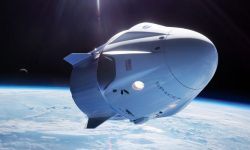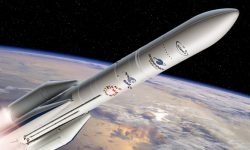
Starlink will soon supply its first customers
– News from March 31, 2020 –
SpaceX’s satellite constellation, Starlink, may be in a monopoly position following the announcement of the bankruptcy of OneWeb. The company is currently continuing to deploy its satellite constellation, apparently without suffering from the same cash flow problems as its competitor.
Starlink infrastructure launch in progress in the United States
The FCC, the organization that manages American telecommunications, approved last week the deployment and distribution of the first million user terminals to the American market.
An antenna that looks like a flying saucer will be placed on a stand. The whole structure will be about half a meter in diameter. Installation will be fairly easy. Just plug in the antenna and point it to the sky, according to Elon Musk.
The first American homes will be connected by the end of 2020
The head of the company reaffirmed the ambition to launch the service by the end of 2020 in North America, and in 2021 for the rest of the world. Starlink hopes to initially capture between 3% and 4% of the market in the U.S.A, which represents several million homes.
We will see if this will generate sufficient revenue to continue to deploy the satellite constellation and to contribute to the financing of the expansion of the human species to the planet Mars, since this remains the long-term objective of SpaceX.

SpaceX begins to deploy its Starlink satellite constellation
– News of May 28, 2019 –
After OneWeb launched a first satellite cluster in February, it is SpaceX’s turn to begin deploying its satellite constellation called Starlink. The solution chosen by SpaceX uses very massive launches with 60 satellites in one Falcon 9. With an individual weight of 227 kg, the payload weighs more than 18 tons. Despite this promising start, we are still far from the number of satellites needed to offer a minimum service. Starlink’s access to the internet can only be commercialized with several hundred satellites in orbit.
Elon Musk also said they still lack some features. To communicate with each other, they will need many ground stations, which will greatly increase the latency of the service. Eventually, the Starlink constellation will use inter-satellite laser communications. In addition, their design must still evolve to be sure that they will disintegrate entirely during their atmospheric reentry. The FCC, the organization that manages telecommunications satellites in the United States, still has some doubts about it.
In parallel with these modifications, the first satellites of the Starlink constellation already show interesting technological choices. They are powered by ion krypton engines, less efficient but also cheaper than xenon. SpaceX continues to focus on economic efficiency. The satellites of the Starlink constellation are also equipped with an automatic space debris avoidance system. We imagine that the experience gained at Tesla may benefit SpaceX.
The work that remains to be done is huge for SpaceX, which wants to place up to 12,000 satellites in its telecommunications constellation. In comparison, all of humanity has launched only 9,000 satellites since the beginning of the space age. The Falcon 9 will not miss work.
SpaceX starts to put into orbit the Starlink satellites constellation
– News of February 14, 2018 –
SpaceX continues to roll out its plans. Next Saturday, a Falcon 9 rocket is expected to put into orbit the first two test satellites of the Starlink constellation. This satellites constellation developed by SpaceX aims to provide a global internet access, a sign of the huge ambition of the American company. SpaceX has applied for authorization to launch 12,000 satellites by the mid-2020s.
The satellites have a unit mass of 400 kg and will be placed in a circular orbit at 1125 km altitude. Their test mission is scheduled to last six months and will be lengthened if satellite capabilities allow. It will test satellite communications equipment and all their ancillary systems. At the end of this mission, the two test satellites will be desorbited. It can be assumed that putting thousands of small satellites into orbit is an ideal job for the Falcon Heavy rocket. It should be able to launch a hundred satellites per launch, if it is able to hold them under its headdress.
As always with SpaceX, the hardest thing is to determine where the reality ends and where the fantasies of Elon Musk begin. To put such a satellites constellation into orbit by the mid-2020s, it will be necessary to accelerate launches. The next flight of the Falcon Heavy is expected to take place in a few months but to put 12,000 satellites into orbit by 2025, the Falcon Heavy would have to make 17 launches of 100 satellites a year from 2019. If the Falcon 9 that does this work, the pace should be insane, especially if we remember that the Falcon 9 has many other missions to complete. A global Internet access service would be a great source of income to allow the development of the BFR and of course to finance the Martian ambitions of the company.
With Starlink, SpaceX could reach billions of customers and garner colossal sums, which would give much more credibility to a Martian settlement project. But do not believe that competition does not do anything. OneWeb is another company that wants to offer internet access via satellite. It has made the request for the putting into orbit of 2000 additional satellites. This is in addition to the 720 satellite constellation that the company had already planned. The first 10 satellites of OneWeb should be launched by a Soyuz rocket this year. The company has different options for launching : Soyuz, Ariane 6, New Glenn and even Virgin Galactic rockets. The Falcon Heavy could be a rocket much more important and perennial that one can believe it, but for that it will have to watch its pace of launching because it is already necessary that it manages to carry out the two additional flights planned from this year.
SpaceX registers Starlink brand for its satellite constellation
– News of September 26, 2017 –
In addition to its Martian projects and commercial launches, SpaceX also wants to become a satellite internet service provider. To achieve this, the US company wants to put into orbit more than 4000 satellites with its launchers Falcon 9 and Falcon Heavy. About a month ago, SpaceX registered the Starlink brand which should be the name of this service. The launches are scheduled to start in 2019. The company would initially deploy 600 satellites in low orbit. This would result in a connection speed similar to optical fiber for users. But even with reusable rockets, it may take a lot of time and cost a lot of money.
They are not satellites of five or six tons in the Starlink constellation. The satellites in the Starlink constellation would weigh 385 kg and be launched in clusters of 50. A first group of 800 satellites could be operational in just 16 launches. The total cost of the project would approach $ 10 billion. If SpaceX manages to realize this project and attract many users around the world, then the company will have a real financial windfall that could finance its Martian projects. But SpaceX is far from being the only company to be interested in offering a new Internet access by air. Google, for example, would also like to offer global internet access, through atmospheric balloons. OneWeb also wants to offer a global internet thanks to a constellation of 650 satellites. OneWeb has already booked 21 Soyuz launches via Arianespace.
To put its constellation of satellites in orbit, SpaceX will also have to find investors because it is unlikely that the company can bear alone the cost of manufacturing thousands of satellites and dozens of launches to achieve. If it becomes a reality, the global satellite internet will introduce a new space technology into all the homes of the planet, in an even more obvious way than the GPS. The next decade will be a double revolution of space and the internet.
Image by Mark Handley/UCL









